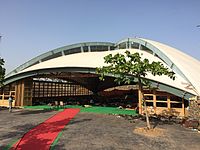Demographics Of Pune City
Population:The population of the Pune city is 3,124,458 and Pune Urban Agglomeration (Pune Metropolitan Area) is 5,057,709 as of the 2011 census. The same was about 4,485,000 in 2005. The migrating population rose from 43,900 in 2001 to 88,200 in 2005. The estimated population in 2016 for the Pune metro region is 6,226,959. According to the Pune Municipal Corporation, 40% of the population lived in slums in 2001.[The sharp increase in censorial decade of 1991–2001 can be attributed to the absorption of 38 fringe villages into the city. The average literacy rate of Pune was 86.15 in 2011 compared to 80.45 in 2001. Marathiis the official and most widely spoken language, while English and Hindi are understood by a significant part of the population. Since Pune is a major industrial metropolis, it has attracted migrants from all parts of India to come and settle here. The top five areas of migration are Karnataka, Uttar Pradesh, Andhra Pradesh, Gujarat, and Rajasthan. The Sindhis in the city are mostly refugees and their descendants, who came to the area after the partition of India in 1947.
Religion
:Hinduism is the dominant religion in Pune. Major communities by religion include Hindus, Muslims, Sikhs, Jains, Buddhists, and Christians. Many Temples, Churches, Mosque, Gurudwaras, Buddhist Viharas, Jewish synagogues, Jain temples, and other religious buildings are found throughout the city. The most prominent Hindu temple in Pune is the Parvati Temple, located on Parvati hill and visible from most of the inner suburbs. The most visited temple is likely the Dagadusheth Halwai Ganapati temple, located in old city area of Pune[citation needed]. Another popular temple is the Goddess Chaturshringi, located on Senapati Bapat road in the north west area of Pune. During [[Navratri] festival], there is a large fair at the temple and worshippers gather from around the country to pray here. The presiding Deity of the city is the Kasba Ganapati in Kasba Peth in central Pune.This temple is believed to be reconstructed when Jijabai lived here in the 1640s with her young son, the future Chhatrapati Shivaji. Sarasbaug Ganpati is also a prominent landmark in Pune.
Islam is the second largest religion in Pune.[64] Pune has a large number of Mosques, the most prominent of which are Chand Tara Masjid, Jaama Masjid, and Azam Campus Masjid. Chand Tara Masjid, located in Nana Peth, is one of the biggest and most important mosques in Pune as it is the city headquarters (markaz) for the Tablighi Jamaat. The Eid-gah Maidan located near Golibar Maidan onShankar Sheth Road witnesses a large gathering of people for Eid namaz on Eid al-Fitr and Eid al-Adha.
Pune has over 20 Gurdwaras. Gurdwara Guru Nanak Darbar, Camp and Gurdwara Shri Guru Singh Sabha, Ganesh Peth being the ones situated in the heart of the city. Sikhism is one of the major religions of Pune and Sikhs have become an integral part of the society. In the past a Sikh has been elected mayor of Pune. The community also runs 2 schools. The Sikh community in Pune celebrates Gurpurabs with a lot of enthusiasm. They also organise Kirtan Darbars yearly which are attended by many important religious figures of the Sikh community as well as other communities. They serve Langar to all irrespective of the caste, creed or race of a person.
Other important religious places of other religions in Pune are the Ohel David Synagogue, The St Peter's Cathedral, Dapodi Church, JJ Agiary.
The Shrutisagar Ashram, located at Phulgaon off the Nagar road, houses the Vedanta Research Centre and a unique temple ofDakshinamurthy, located near the confluence of the Bhima, Bhama, and Indrayani rivers. It was established in 1989 by Swami Swaroopanand Saraswati. Here one can find detailed explanations of śruti and smriti (including the Vedas, Bhagavad Gita, Upanishads and Puranas) in Marathi and English. As of the 2011 census, the population of Pune is as follows.








No comments:
Post a Comment